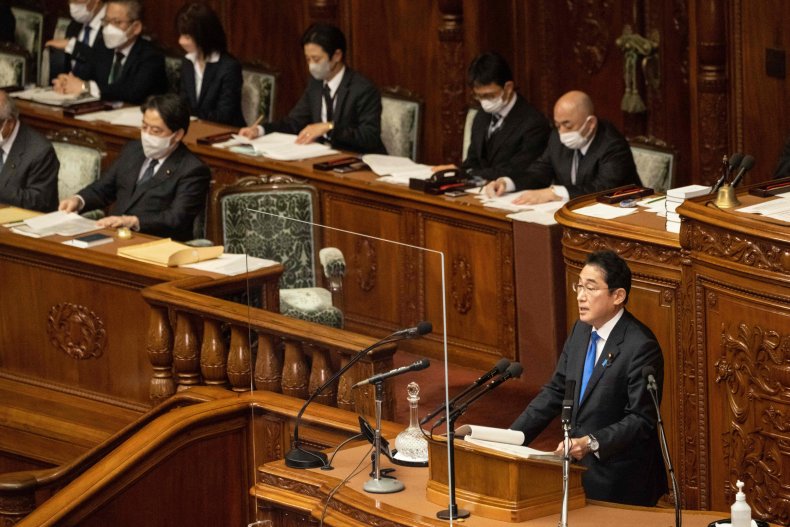Acquainted alarm bells sounded in Japan this month as year-end inhabitants figures and new projections mixed to color an unsure future for Asia’s No. 2 financial system.
Japan’s complete inhabitants stood at 124.94 million for the 12 months to October, a decease of over half 1,000,000 folks from 2021 in a twelfth consecutive annual decline, in keeping with a report this month by its Statistics Bureau. The working inhabitants, aged 15 to 64, fell to 74.2 million, and people above 65 reached 36.23 million—each respective data.
The worrying information—already watched for years—emerged on the tail finish of the Japanese financial miracle, which abruptly ended within the early Nineties. Low start charges and excessive life expectancy collectively pose an unprecedented demographic problem to Tokyo’s policymakers, whose options are also being scrutinized in neighboring capitals.
The pace of Japan’s depopulation affected all prefectures final 12 months aside from Tokyo and has outpaced official projections. In 2022, the variety of newborns dipped under 800,000 for the primary time since surveys started in 1899. The federal government beforehand had anticipated fewer than 815,000 births in 2027.
If current tendencies holds, annual births may fall under half 1,000,000 in 2059, the well being ministry-affiliated Nationwide Institute of Inhabitants and Social Safety Analysis, or IPSS, mentioned on Wednesday in its twice-a-decade estimate.
Japan’s fertility charge of about 1.3 was among the many lowest within the membership of largely rich nations that make up the Group for Financial Cooperation and Improvement. Solely Italy’s 1.24 and South Korea’s 0.78 have been decrease. All fell properly under the OECD commonplace of two.1 to keep up a steady inhabitants.
On the opposite finish of the spectrum, Japan’s “super-aged” society—outlined as when no less than 20 % of the inhabitants is above 65—was including to an already important social safety burden for the nation’s working-age residents, who accounted for a record-low 59.4 % of the inhabitants final 12 months.
The aged inhabitants hit a record-high 29 % and will attain 38.7 % within the subsequent half a century, the IPSS mentioned. In accordance with its forecast, life expectancy in Japan may climb to 91.94 years for girls and 85.89 years for males over the identical interval.
Japan’s inhabitants, which peaked in 2008 at 128 million, may fall to 87 million by 2070, mentioned the report. It revised its 2017 estimate for when the inhabitants would dip under 100 million, from 2053 to 2056, to account for an anticipated improve within the share of international nationals within the nation, up from 2.2 % in 2021 to 10.8 % in 50 years’ time.
Time, Not Cash
The attitudes of Japan’s youths have develop into vital indictors of demographic points which have since sprung up in different superior economies within the area. Rolling public opinion polls discover extra respondents delaying marriage or youngsters—generally indefinitely—due to a job market in flux and the excessive value of residing.
Japanese girls, particularly those that go on to obtain increased training, face incompatible company cultures and household customs which are nonetheless certain by conventional gender roles. These tensions are among the many explanation why some would-be dad and mom are reluctant to boost youngsters within the present setting, regardless of a need to take action.
For the primary time in Japan’s postwar historical past, a majority of girls aged 18 to 34 mentioned they hoped to marry however deliberate to have fewer than two youngsters, in keeping with the outcomes of a 2021 IPSS survey launched final fall. In the identical age bracket, a report variety of women and men—17.3 and 14.6 %, respectively—mentioned they did not intend to marry in any respect.
Buddhika Weerasinghe/Getty Pictures
Masanobu Ogura, Japan’s youngsters’s minister, cited the info in late March when he unveiled proposals that represented “a final probability” to reverse the decades-long downtrend. The plans, to be overseen by a brand new Youngsters and Households Company launched on April 1, have been an enlargement of previous insurance policies that largely had failed to maneuver the needle in significant methods.
To additional scale back the monetary burden of child-rearing, the federal government will provide subsidies to cowl childbirth and education, with households anticipated to obtain tens of 1000’s of {dollars} all through a new child’s early childhood and adolescence. For fogeys, the introduction of versatile work preparations will, on paper, encourage extra co-parenting.
“Whereas various views about marriage, childbirth and child-rearing must be revered, we wish to make a society the place younger generations can marry, have and lift youngsters as they want,” mentioned Ogura, whose long-ruling conservative get together backs conventional household values.
“The essential route of our measures to sort out low births is to reverse the pattern of declining births by supporting people’ pursuit of happiness,” he mentioned.
The federal government’s new measures might by a stopgap for some households, however they depart Japan’s inflexible gender norms unaddressed. It is also unclear whether or not they can successfully provide the working mom extra of her most respected useful resource: time, ordinarily spent on youngsters however dad and mom and in-laws, too. At practically a 3rd of the inhabitants, senior residents are a pressure to be reckoned with in Japan’s democratic system.
“Japan is about 10 or 20 years forward of different nations which are going via this as properly, and so they’re setting the groundwork of what to do and what to not do,” mentioned Erin Murphy, a senior fellow on the Middle for Strategic and Worldwide Research and deputy director of its Economics Program.
“Japanese girls are in the identical boat as South Korean girls, who’ve been much more vocal round points like youngster care and parental depart. One other is fertility therapy for girls who wish to have youngsters later in life whereas advancing their careers—it is very costly and never as accepted. Authorities responses to those huge points have been lackluster,” Murphy instructed Newsweek.
“Ladies aren’t actually welcome again into the workforce after they’ve children; there is a excessive expectation that they need to keep dwelling. There’s additionally the next burden on girls to handle the youngsters and the home on high of a full-time job, in the event that they’re in a position to hold it. And there are too few girls within the halls of energy to make coverage,” she mentioned.

iStock / Getty Pictures
Conservative policymakers and a cautious public imply Japan is more likely to search for inside, relatively than exterior, options to the demographic crunch, regardless of projections pointing to the inevitability of extra immigration.
“Some say it isn’t an issue to have a low fertility charge. That is OK if folks positively select this feature. However the level is almost all of comparatively younger folks wish to get married, kind a brand new household and have children, however they must compromise,” mentioned Sawako Shirahase, a sociology professor on the College of Tokyo, who researches gender and generational points.
“Japan has a peculiar historical past associated to immigration coverage. Within the Sixties and Nineteen Seventies, Japan succeeded with financial development with out new immigrants and have become the primary Asian nation to attain industrialization with a really conservative division of labor. Nevertheless it wasn’t sustainable as a result of it could not reconcile completely different roles inside the identical folks on the identical time,” she instructed Newsweek.
“This mannequin is kind of environment friendly in a really quick time frame, nevertheless it would not final that lengthy. Ladies get increased training and have extra decisions, however in actuality their choices are restricted after they have to decide on between work and household,” Shirahase mentioned.
Japan Tomorrow
Structural inhabitants issues are a problem for anybody chief to resolve, however the future fallout will likely be borne by all.
It wasn’t so way back that the perceived menace of Japan’s industrial increase permeated via widespread tradition in america, earlier than its post-Chilly Struggle drop-off crowded out anti-Japanese sentiment. In the present day’s bleak demographic outlook is definite to threaten Japan’s standing because the world’s third-largest financial system.
A threat evaluation in March by the Recruit Works Institute predicted the nation’s labor shortfall would exceed 11 million staff by 2040. By the top of this decade, nonetheless, Japan first would face a logistics disaster that would depart over a 3rd of freight undelivered as a result of new additional time rules starting subsequent 12 months, in keeping with a January research by the Nomura Analysis Institute.
“The financial affect might be fairly extreme. The first concern is a shrinking tax base that in any other case contributes to the operating of presidency providers. It raises questions concerning the varieties of selections that should be made on administrative prices,” Murphy mentioned.
“Japan gives an attention-grabbing instance of a rustic that’s fairly anti-immigration, and so they appear unlikely to embrace that chance. So how do you allocate assets? How do you retain companies going when there is no buyer base? How do you create the tax base to assist public transportation and fund nationwide well being care? How do you handle the aged?” she mentioned.
Prime Minister Fumio Kishida declared in January that the creation of a “youngsters first” society may now not be postponed. “Japan is on the verge of whether or not we are able to proceed to perform as a society,” he mentioned.

YUICHI YAMAZAKI/AFP by way of Getty Pictures
The U.S., which counts Japan as one among its most vital treaty allies, additionally has a stake in whether or not Japan’s leaders get it proper. The trajectory of Japanese manpower could have nationwide safety implications for each capitals as they arrive collectively to face an more and more assertive China, for which Tokyo has already dedicated to an arms buildup set to final for many years.
“Japan goes to have to determine what its navy trade seems to be like. Is it based mostly on human capital or know-how? This can be a query confronted by different U.S. allies, too, and it is also a dialogue about what the way forward for warfare seems to be like,” added Murphy.
The shrinking inhabitants is being constructed into Japan’s protection planning. In a white paper final 12 months, its Protection Ministry referred to as it an “imminent problem” to the sustainability and resilience of Japan’s Self-Protection Forces, which must offset the dwindling numbers by buying extra autonomous and unmanned methods whereas decommissioning {hardware} with “low value effectiveness.”
In an initiative to have a navy that “adapts to the instances and setting,” the ministry mentioned it will faucet Japan’s largest but underutilized human useful resource: girls. Feminine service members accounted for 8.3 % of personnel in March 2022, the doc mentioned. Its objective since 2021 has been to make sure 35 % of recruits are girls.
The Japanese authorities stays primarily accountable for the demographic pattern, Shirahase mentioned. Discovering the fitting reply would require sturdy management and a willingness to expend political capital in partaking all related stakeholders.
“This can be a central concern of society. We’ve got so as to add yet one more widespread worth to make change occur. All of us must be concerned in nurturing future generations. We’ve got to persuade the older era or the working era that intergenerational mutual assistance is essential to our survival. This can be a essential mental argument, and training is the ultimate device.”
Do you have got a tip on a world information story that Newsweek must be overlaying? Do you have got a query about Japan? Tell us by way of [email protected].


